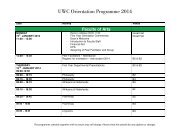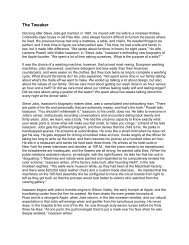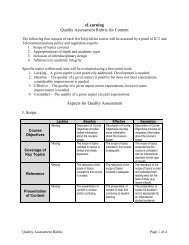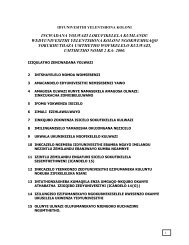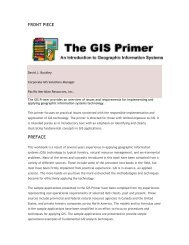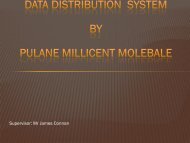Ecosystem Guidelines for Environmental Assessment
Ecosystem Guidelines for Environmental Assessment
Ecosystem Guidelines for Environmental Assessment
Create successful ePaper yourself
Turn your PDF publications into a flip-book with our unique Google optimized e-Paper software.
TABLE 4: EXAMPLES OF SPATIAL COMPONENTS OF ECOLOGICAL PROCESSES AND THEIR LOCATION<br />
TYPE<br />
OBJECTIVES & CHARACTERISTICS<br />
SCALE AT WHICH SPATIAL COMPONENTS<br />
OF ECOLOGICAL PROCESSES FUNCTION<br />
- To maintain migration and exchange between inland and coastal<br />
biotas (and also between lowland and upland biotas) by protecting<br />
riverine habitats that function as ecological corridors<br />
- Riverine corridors in many lowland areas retain some of the last<br />
remaining semi-continuous patches of natural vegetation and<br />
thus have special significance in terms of providing ecological<br />
connectivity between areas<br />
- Migration of plant species along riverine corridors has resulted<br />
in species diversification<br />
- Riverine corridors may also serve as fire refugia. The lower<br />
frequency of fire results in a different plant and animal community<br />
- Riverine corridors also serve as refugia from drought and have<br />
provided refugia <strong>for</strong> mesic species during major climatic events<br />
in the past<br />
- Ecological processes can function at a very wide scale in the<br />
case of riverine systems that breach the Cape Fold Belt and link<br />
the Karoo basin with the coastal <strong>for</strong>elands<br />
- The scale is reduced with single drainage basins – and even more<br />
so with individual tributaries – on the coastal plain<br />
EXAMPLES<br />
VEGETATION BOUNDARIES<br />
ECOLOGICAL CORRIDORS<br />
UPLAND-LOWLAND<br />
INTERFACES AND<br />
BIOME BOUNDARIES<br />
(THICKET-FYNBOS)<br />
SOIL INTERFACES<br />
SAND MOVEMENT<br />
CORRIDORS<br />
RIVER CORRIDORS<br />
- The inland movement of marine sands represents a dynamic<br />
process that drives ecosystem functioning and determines<br />
biodiversity patterns.<br />
- Sand deposits create a complex sequence of sediments of various<br />
ages and chemistries associated with unique, soil-specific plant<br />
assemblages and diversification of species.<br />
- Sediment corridors can also be important links <strong>for</strong> coastal thicket<br />
- Sediment corridors can be important links in the seasonal<br />
replenishment of sand <strong>for</strong> bathing beaches<br />
- The entire system, i.e. from source (input) to core and sink<br />
(outgoing) areas and adjacent habitat. These systems are often<br />
in the <strong>for</strong>m of headland bypass dunes (i.e. cross a peninsula or<br />
headland that cuts across the prevailing wind direction)<br />
- Certain dune plumes may be as small as 10 ha, but many cover<br />
hundreds or even thousands of hectares<br />
- In the STEP planning domain, sand movement corridors were<br />
considered functional if less than 50% of each section had been<br />
trans<strong>for</strong>med by agriculture and urbanisation. Dense alien stands<br />
can ‘choke off’ the movement of sediments between source and<br />
sink areas<br />
- Maintain ecological diversification of plant and animal lineages<br />
in response to fine-scale gradients<br />
- For the CAPE conservation planning programme, fine-scale<br />
edaphic gradients entailed ca.1 000 ha areas of juxtaposed and<br />
strongly contrasting edaphic habitats<br />
- These interfaces may be visible on the ground over a few metres,<br />
often as a staggered mosaic rather than as a purely linear divide,<br />
and are often marked by a change in topography, such as a break<br />
of slope<br />
- To maintain ecological diversification of plant and animal lineages.<br />
- To support faunal seasonal migration.<br />
- Areas spanning upland-lowland gradients.<br />
- In STEP planning domain, identified as a 500 m wide buffer of<br />
untrans<strong>for</strong>med habitat along interfaces between solid thicket<br />
and vegetation of the adjacent biome<br />
- These boundaries can also correspond with ecotones such as<br />
between sandstone fynbos-renosterveld-succulent karoo, or<br />
shale renosterveld-granite renosterveld-granite fynbos<br />
The Gouritz River corridor (widescale; links Nama Karoo-Succulent<br />
Karoo to the Indian Ocean coast)<br />
Coastal plain section of the Gouritz River (Riversdale Plain)<br />
Olifants-Doring (links Tankwa Karoo with Sand Fynbos of West<br />
Coast <strong>for</strong>elands)<br />
Goukou River (links Langeberg mountains to the Indian Ocean<br />
coastline)<br />
Breede River (links Fynbos and Succulent Karoo biomes with coast)<br />
All rivers that are not irreversibly degraded should be included in<br />
biodiversity networks to assist in conserving ecological processes<br />
across landscapes<br />
West Coast: Atlantis, south of Langebaan, north of Eland’s Bay,<br />
extensive areas north of Lambert’s Bay<br />
Cape Peninsula: Hout Bay-Sandy Bay (now largely destroyed),<br />
Witsand, Buffels Bay, Strandfontein coastline<br />
South Coast: Betty’s Bay-Hanglip, Walker Bay, Quoin Point,<br />
Agulhas, Waenhuiskrans–De Hoop, Gouriqua, Kanon-Vleesbaai,<br />
Goukamma, Robberg Peninsula.<br />
There are numerous examples, e.g.:<br />
West Coast: Saldanha Strandveld (limestone or granite) abutting<br />
Atlantis, Cape Flats and Leipoldtville Sand Fynbos (acid sands);<br />
also between various Renosterveld types (alkaline shales,<br />
occasionally granites) and Sand Fynbos and Sandstone Fynbos<br />
types (acid sands)<br />
De Hoop: De Hoop Limestone Fynbos (limestone) and Potberg<br />
Sandstone Fynbos (acidic sands) and Rûens Shale Renosterveld<br />
(clay)<br />
Riversdale Plain: Canca Limestone Fynbos (limestone and calcrete),<br />
Mossel Bay Shale Renosterveld (clay), and Swellendam Silcrete<br />
Fynbos (silcrete) and Albertinia Sands Fynbos (acid sands)<br />
Upland-lowland vegetation boundaries, e.g.:<br />
Coastal plain/coastal mountain range (e.g. Riversdale Plain-<br />
Langeberg)<br />
Coastal range/interior basins (e.g. Langeberg-Little Karoo)<br />
Inland range/interior basins (e.g. Klein Swartberg-<br />
Moordenaarskaroo<br />
Inland range/Karoo basin (e.g. Roggeveld-Great Karoo)<br />
Biome boundaries: Interface of solid thicket and fynbos, grassland,<br />
succulent karoo or Nama karoo biomes.<br />
SCEPS<br />
84 : SPATIAL COMPONENTS OF ECOLOGICAL PROCESSES



